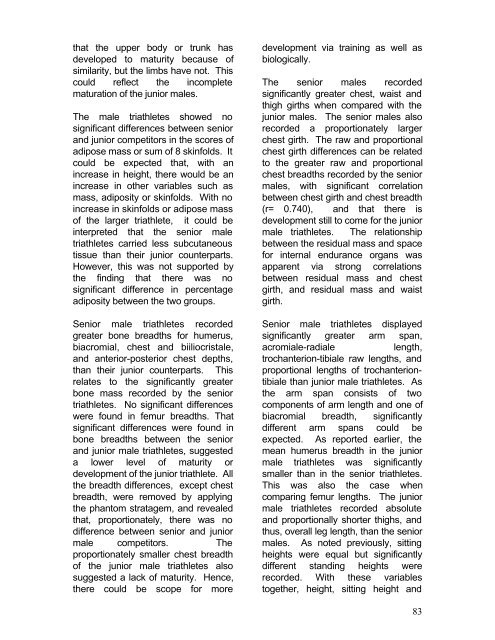MAXIMISING OLYMPIC DISTANCE TRIATHLON PERFORMANCE ...
MAXIMISING OLYMPIC DISTANCE TRIATHLON PERFORMANCE ...
MAXIMISING OLYMPIC DISTANCE TRIATHLON PERFORMANCE ...
You also want an ePaper? Increase the reach of your titles
YUMPU automatically turns print PDFs into web optimized ePapers that Google loves.
that the upper body or trunk hasdeveloped to maturity because ofsimilarity, but the limbs have not. Thiscould reflect the incompletematuration of the junior males.The male triathletes showed nosignificant differences between seniorand junior competitors in the scores ofadipose mass or sum of 8 skinfolds. Itcould be expected that, with anincrease in height, there would be anincrease in other variables such asmass, adiposity or skinfolds. With noincrease in skinfolds or adipose massof the larger triathlete, it could beinterpreted that the senior maletriathletes carried less subcutaneoustissue than their junior counterparts.However, this was not supported bythe finding that there was nosignificant difference in percentageadiposity between the two groups.Senior male triathletes recordedgreater bone breadths for humerus,biacromial, chest and biiliocristale,and anterior-posterior chest depths,than their junior counterparts. Thisrelates to the significantly greaterbone mass recorded by the seniortriathletes. No significant differenceswere found in femur breadths. Thatsignificant differences were found inbone breadths between the seniorand junior male triathletes, suggesteda lower level of maturity ordevelopment of the junior triathlete. Allthe breadth differences, except chestbreadth, were removed by applyingthe phantom stratagem, and revealedthat, proportionately, there was nodifference between senior and juniormale competitors. Theproportionately smaller chest breadthof the junior male triathletes alsosuggested a lack of maturity. Hence,there could be scope for moredevelopment via training as well asbiologically.The senior males recordedsignificantly greater chest, waist andthigh girths when compared with thejunior males. The senior males alsorecorded a proportionately largerchest girth. The raw and proportionalchest girth differences can be relatedto the greater raw and proportionalchest breadths recorded by the seniormales, with significant correlationbetween chest girth and chest breadth(r= 0.740), and that there isdevelopment still to come for the juniormale triathletes. The relationshipbetween the residual mass and spacefor internal endurance organs wasapparent via strong correlationsbetween residual mass and chestgirth, and residual mass and waistgirth.Senior male triathletes displayedsignificantly greater arm span,acromiale-radialelength,trochanterion-tibiale raw lengths, andproportional lengths of trochanteriontibialethan junior male triathletes. Asthe arm span consists of twocomponents of arm length and one ofbiacromial breadth, significantlydifferent arm spans could beexpected. As reported earlier, themean humerus breadth in the juniormale triathletes was significantlysmaller than in the senior triathletes.This was also the case whencomparing femur lengths. The juniormale triathletes recorded absoluteand proportionally shorter thighs, andthus, overall leg length, than the seniormales. As noted previously, sittingheights were equal but significantlydifferent standing heights wererecorded. With these variablestogether, height, sitting height and83


